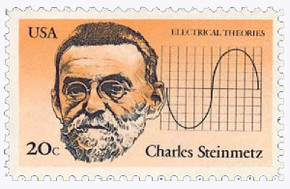
U.S. #2055-58
1983 20¢ American Inventors
Block of 4
- Stamps issued to honor some of America's top inventors
- Feature portraits and depictions of their inventions
Stamp Category: Commemorative
Set: American Inventors
Value: 20¢, first-class rate
First Day of Issue: September 21, 1983
First Day City: Washington, DC
Quantity Issued: 48,263,750 blocks
Printed by: Bureau of Engraving and Printing
Printing Method: Lithographed and engraved
Format: Panes of 50 in sheets of 200
Perforations: 11
Why the stamps were issued: To honor some of America's top inventors.
About the stamp designs: Dennis Lyall designed the block of four American Inventors stamps. As each man had lived since the advent of the camera, he was able to create his stamp portraits from photographs. He also included text describing the invention or discovery they were best known for as well as a depiction of it.
Charles Steinmetz – Electrical Theories – This is the only stamp in the set that doesn’t picture a physical invention. Instead, it pictures a graph representing the square root of minus one.
Edwin Armstrong is pictured alongside his frequency modulator.
Nikola Tesla appears beside his induction motor.
Philo T. Farnsworth is depicted with his first television camera.
First Day City: The designs for these stamps were unveiled three months earlier at a banquet marking the 10th anniversary of the Institute of Electrical and Electronic Engineers. Each of the four inventors had a connection to the institute or one of its two predecessors. The First Day ceremony for the stamps was held at the US Patent and Trademark Office in Arlington, Virginia.
Unusual fact about these stamps: Error stamps exist with the black intaglio missing or dramatically shifted.
History the stamps represent: Mathematician and electrical engineer Charles Proteus Steinmetz was born Karl August Rudolph Steinmetz on April 9, 1865, in Breslau, Province of Silesia, Prussia. Steinmetz developed the electrical theories that allowed for the expansion of the electric power industry. Steinmetz was famous for being able to create man-made lightning in a laboratory the size of a football field. That earned him the nicknames, “Forger of Thunderbolts” and “Wizard of Schenectady.”
Nikola Tesla was a groundbreaking scientist whose research in electricity and magnetism provided much of the foundation of modern physics. Tesla, who was born in 1856 in Austria, came to the United States in 1884. He had worked for the Continental Edison Company in Paris, but moved to New Jersey to work with Thomas Edison. Then 28, Tesla took a letter to Edison from respected inventor Charles Batchelor. Batchelor wrote, “I know two great men; one is you (Edison) and the other is this young man.” While working with Edison, Tesla improved Edison’s direct-current (DC) electricity fields. He then improved on the idea by developing the superior alternating-current (AC) concept, which is still in use today. Tesla also invented the induction motor (a type of AC motor), which inspired the “Second Industrial Revolution” in the 20th century. Tesla developed so many important theories and advances that he is called the “Father of Physics.”
Edwin Armstrong was an electrical engineer who developed the theory of frequency modulation (FM) for use in radio. FM broadcasts give superior sound quality to AM (amplitude modulation). Armstrong patented wideband FM in 1933, but it took years for the work to be fully developed. He received the “Legion of Honor” (the highest decoration) from the French government in 1919 for his wartime work with radio.
The “Father of Modern Television” is one nickname given to Philo Farnsworth. Farnsworth developed the image dissector camera tube (a type of electron tube) during the 1920s. The tube was first demonstrated in 1927, but had actually been developed in 1922 – when Farnsworth was a freshman in high school! By using electrical output to project images, Farnsworth laid the groundwork for modern television. He produced work critical to development of air traffic control. Farnsworth even made advances in the fields of radar and electron microscopes.










